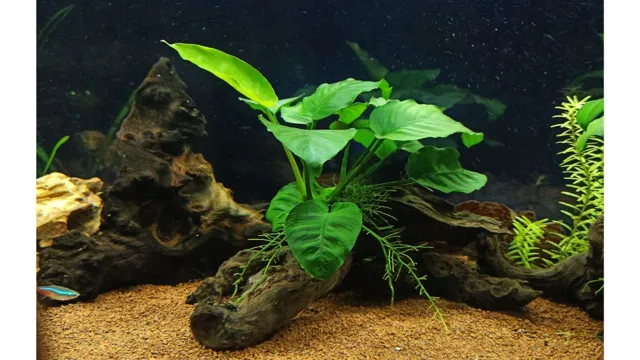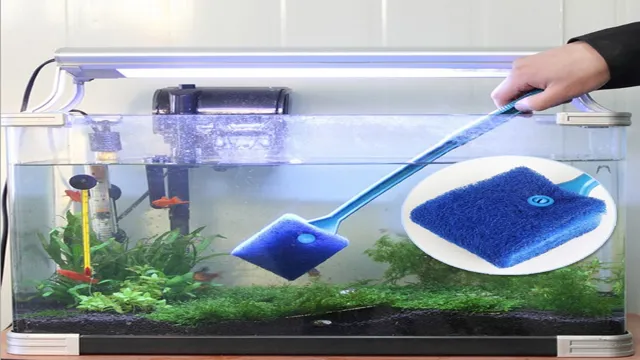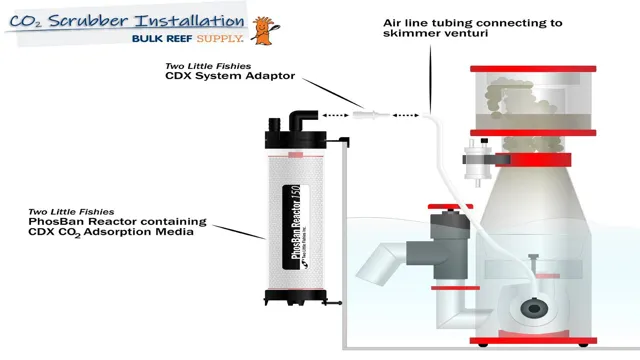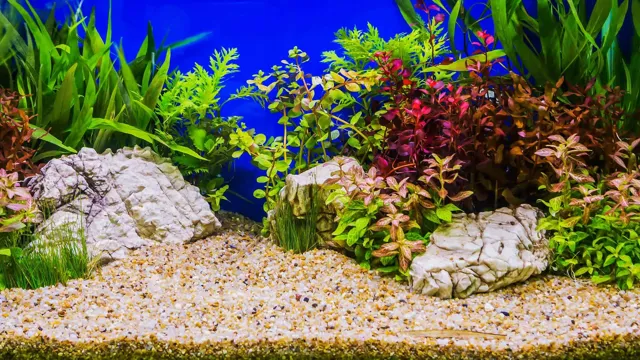How to Disinfect an Aquarium with Vinegar: A Step-by-Step Guide for Safe and Effective Cleaning
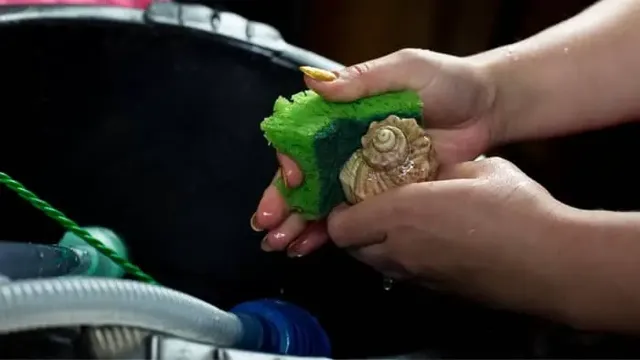
When it comes to aquarium maintenance, disinfecting the tank is an essential task to keep your aquatic pets healthy and thriving. But what if you’re looking for a natural, non-toxic solution? Enter vinegar. Yes, you read that right – vinegar can be a highly effective way to disinfect your aquarium without harming your fish or plants.
Plus, it’s affordable and accessible. But before you start pouring vinegar into your tank, let’s take a closer look at how to properly disinfect with this household staple.
Introduction
If you’re wondering how to disinfect an aquarium with vinegar, you’re in luck because it’s a simple process. First, empty the aquarium and remove all decorations and plants. Then, mix a solution of one part vinegar to ten parts water and use a clean cloth or sponge to wipe down the entire interior of the tank.
Be sure to scrub all surfaces, including corners and seams, and let the solution sit for at least 15 minutes. Afterward, rinse the aquarium thoroughly with clean water, making sure to remove all traces of vinegar. Lastly, allow the aquarium to air-dry completely before adding fresh water and any decorations or plants.
By following these steps, you can effectively disinfect your aquarium using a common household item – vinegar!
Understanding the Importance of Aquarium Maintenance
Aquarium maintenance is a crucial aspect of keeping fish and other aquatic creatures healthy in their confined environments. Neglecting proper maintenance can result in algae growth, polluted water, and ultimately harm the inhabitants of the aquarium. It may seem daunting to maintain an aquarium, but it’s a lot like having a pet, requiring some time and effort to keep it healthy.
With regular water changes, cleaning the tank and the filters, and ensuring the pH levels are balanced, you can keep your tank environment healthy and thriving. So, if you want to keep your aquarium flourishing and the aquatic creatures happy, it’s important to prioritize regular maintenance and follow the best practices for proper upkeep.
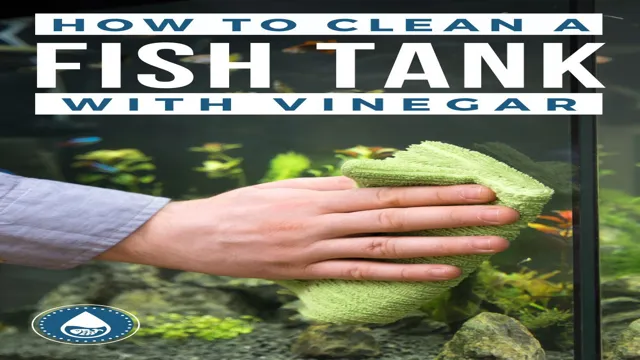
Why Use Vinegar?
Vinegar is commonly used in cooking and as a condiment, but did you know that it also has many other uses? This acidic liquid is often used as a natural cleaner, disinfectant, and even pesticide due to its antimicrobial properties. Vinegar can also be used to preserve food, as a remedy for certain ailments, and to enhance the flavor of dishes. Its versatility and affordability make it an excellent addition to any household, and its benefits go beyond the kitchen.
So, why use vinegar? Simply put, it’s a natural and effective solution for a variety of purposes.
Preparing the Aquarium for Disinfection
If you’re wondering how to disinfect an aquarium with vinegar, then there are a few important steps you need to take to prepare the tank first. Before you start using the vinegar solution, you must remove the fish and any decorations or plants that are inside the aquarium. Be sure to keep them in a separate container filled with water that has the same temperature as the tank to ensure they stay healthy while the cleaning is underway.
Once the tank is empty, you’ll need to remove as much of the water as possible. Depending on the size of the tank, you can do this by using a bucket or a siphon hose. Make sure you get as much debris out as possible before proceeding.
Once the tank is dry, mix a vinegar solution with 1-part vinegar and 3 parts water. Use it to wipe down all surfaces of the tank, including the walls and bottom. Let the solution sit for 30 minutes before rinsing the tank with clean water multiple times.
Once the tank is dry, you can refill it with water and add the decorations and plants before reintroducing your fish. By following these steps, you’ll be able to maintain a clean and healthy environment for your aquatic pets.
Removing Fish and Other Aquatic Animals
When it comes to disinfecting your aquarium, the first step is to prepare it for the process. One crucial step is removing all fish and other aquatic animals. This may seem like an obvious step, but it’s essential to ensure that no creatures are harmed during the disinfection process.
You can move them to a temporary holding tank or a clean aquarium that has not yet been disinfected. But before you remove any animals, you should turn off all equipment and let the water settle for a while. This helps to calm the animals, making them easier to catch and move.
When it’s time to remove them, do so gently and carefully to avoid injuring them. Another important factor to consider when preparing your aquarium for disinfection is the cleaning supplies you’ll be using. Always use disinfectants that are safe for aquatic animals and follow the manufacturer’s instructions carefully.
It’s also essential to thoroughly rinse all equipment and surfaces to remove any residue after disinfection. Overall, preparing your aquarium for disinfection requires careful planning and attention to detail. But by taking the time to do it right, you can ensure that your aquarium stays healthy and beautiful for years to come.
Draining the Aquarium
Draining an aquarium can be a daunting task, especially if you’re not sure how to do it correctly. Before you start, make sure you have buckets nearby, as well as a siphon tube. Turn off any equipment, including filters and heaters, and unplug them from the wall.
Begin by removing any decorations or plants from the aquarium, and then start siphoning the water out. Gradually lower the tube until it reaches the gravel, being careful not to suck up any small fish or debris. Once the water level has dropped, remove the remaining water and any debris or uneaten food from the aquarium.
Rinse the gravel thoroughly under running water to remove any remaining waste. After draining the aquarium, it’s crucial to prepare it for disinfection to ensure that there are no harmful pathogens or parasites left behind. Organic disinfectants like hydrogen peroxide can be a great way to cleanse the tank without harsh chemicals.
Cleaning the Tank
Cleaning the tank of your aquarium is an important task that should be done regularly to maintain a healthy and thriving environment for your fish. Before disinfecting the tank, it is important to prepare it properly. First, remove all the decorations, rocks, and substrate from the tank.
Then, siphon out as much water as possible and dispose of it properly. Use a soft brush or sponge to gently scrub the sides of the tank to remove any algae or debris. Finally, wipe the tank down with a clean cloth to remove any dirt or residue.
This will ensure that the disinfectant can work properly and effectively in the next step. It is crucial that you use a disinfectant specifically formulated for aquariums as other cleaners can be harmful to fish. One of the most effective disinfectants is bleach, but it must be used carefully and rinsed thoroughly afterward to avoid any harm to your fish.
By properly preparing your tank for disinfection, you can ensure a healthy and thriving environment for your aquatic pet and enjoy their beauty for years to come.
Disinfecting the Aquarium with Vinegar
If you’re looking for a natural method for disinfecting your aquarium, vinegar is a great option. Not only is it effective, but it’s also safe and inexpensive. To start, you’ll want to remove any fish or plants from the tank and drain the water.
Then, mix a solution of one part vinegar to nine parts water and use it to scrub the walls and accessories of the tank. Make sure to let the solution sit for at least 15 minutes before rinsing thoroughly with clean water. Vinegar is a great natural disinfectant, as it has antimicrobial properties that can kill harmful bacteria and viruses that can affect the health of your aquatic pets.
Just be sure to rinse the tank thoroughly and allow it to air dry before refilling it. With this simple and cost-effective method, you don’t have to rely on harsh chemicals to keep your aquarium clean and healthy.
How to Dilute Vinegar Properly
If you’re looking for a natural way to disinfect your aquarium, vinegar is a great option. However, it’s important to dilute it properly to avoid harming your fish. To start, mix one part vinegar with ten parts water to create the solution.
Once you have your solution, use a clean cloth or sponge to wipe down all surfaces of the aquarium, including the glass, filter, and decorations. Rinse everything thoroughly with clean water before filling the tank back up with fresh water. Vinegar is effective at killing bacteria and other harmful microorganisms, making it a great choice for cleaning and disinfecting your aquarium.
Just remember to always dilute it properly and rinse thoroughly before adding your fish back in.
Applying the Vinegar Solution to the Aquarium
Vinegar is an excellent solution for disinfecting an aquarium and is also a highly cost-effective way to do so. It works by creating an acidic environment that is harsh on bacteria but safe for fish. However, it’s essential to use white vinegar as opposed to apple cider vinegar, which can leave a residue.
Before applying the vinegar solution, remove the fish and plants from the aquarium, along with any decorations. Then, mix one part vinegar with five parts water in a spray bottle. Spray the mixture generously around the tank, including the lid, filter, and all surfaces.
Leave the solution to work for at least an hour before rinsing the aquarium with warm water. After rinsing and drying the tank, you can add the fish and plants back in. But, if you notice any leftover vinegar smell, rinse the tank once more before re-adding the fish and decorating.
This natural, cheap, and straightforward disinfecting solution will keep your aquarium fresh and clean, ensuring a safe and healthy environment for your aquatic pets.
Tools You Will Need
When it comes to disinfecting your aquarium, one of the best tools you can use is vinegar. You’ll need a few supplies, such as a bucket, scrub brush, and measuring cup. Start by draining the water from the tank and removing any decorations or plants.
Mix one part vinegar with three parts water in the bucket, and use the scrub brush to clean the tank thoroughly. Be sure to pay special attention to any algae or grime that may have accumulated. Once you’re finished, rinse everything with fresh water several times to ensure all the vinegar has been removed.
Vinegar is a great disinfectant because it’s cheap, safe, and effective. Plus, it won’t harm your fish the way some chemical cleaners might. Using vinegar to disinfect your aquarium is an easy and affordable way to keep your fish healthy and happy.
Final Tips and Precautions
When using vinegar to disinfect an aquarium, it’s important to take some extra precautions to ensure the health and safety of your fish. First and foremost, never add vinegar directly to the aquarium water. Instead, mix a solution of one part vinegar to five parts water in a separate container and use it to clean any surfaces or decorations that need disinfecting.
Rinse everything thoroughly with clean water before returning it to the tank. Be sure to monitor ammonia and pH levels for a few days after cleaning to ensure the vinegar hasn’t negatively impacted the aquarium’s ecosystem. Additionally, avoid using vinegar on any items made of porous materials, such as wood or certain types of rocks, as it can damage or weaken them.
Overall, vinegar can be a safe and effective way to disinfect your aquarium, but it’s important to use it properly and take the necessary precautions to protect your fish.
Rinsing the Tank Thoroughly
When it comes to cleaning your fish tank, it’s important to not forget the final step of rinsing the tank thoroughly. After you have cleaned the tank with a scrub brush and removed any debris, it’s important to rinse the tank several times with clean water. This will help remove any leftover cleaning solution or particles that may still be in the tank, which could harm your fish if left unchecked.
Make sure to use fresh water and rinse the tank thoroughly a few times before refilling it. Additionally, you may want to consider using a water conditioner to ensure that the water is safe and healthy for your aquatic pets. By taking these final steps and ensuring that your tank is clean and free of harmful chemicals, you can ensure that your fish are happy and healthy in their home.
Avoiding Harmful Chemical Reactions
In order to avoid harmful chemical reactions when working with chemicals, it is important to take certain precautions. First and foremost, always wear appropriate protective gear such as gloves, goggles, and a lab coat. Make sure to store chemicals properly in their original containers and keep them away from heat sources.
Before mixing any chemicals, thoroughly research their properties and potential reactions to ensure they are compatible. It is also crucial to never mix chemicals without proper training and supervision. Always work in a well-ventilated area and never inhale or taste any chemicals.
By following these tips, you can prevent dangerous reactions and protect yourself and those around you.
Reintroducing Fish and Other Aquatic Animals
When it comes to reintroducing fish and other aquatic animals, it is important to take certain precautions to ensure their successful recovery. One of the main things to consider is the quality of the water in which they will be reintroduced. It is essential to make sure that the water is clean and free of any pollutants that could harm the animals.
Another important factor is the timing of the reintroduction. It is best to wait until the environmental conditions are suitable and the animals have the best chance of thriving. Finally, it is crucial to monitor the animals closely after they have been reintroduced to their natural habitat.
This will help to identify any issues that may arise and allow for prompt action to be taken. Reintroducing fish and other aquatic animals can be a complex process, but by taking these precautions, we can help to ensure the successful recovery of these important species.
Conclusion
In conclusion, if you’re looking for a cost-effective and natural way to disinfect your aquarium, vinegar is the solution you’ve been looking for! Not only is it mild and safe for your fish, but it also efficiently kills bacteria and removes unwanted build-up. So, whether you’re a seasoned aquarist or a newbie, next time you’re thinking about how to disinfect your tank, just remember: vinegar is the real vinegarial! Happy scrubbing!”
FAQs
Can I use vinegar to disinfect my aquarium?
Yes, vinegar can be used to disinfect your aquarium.
What is the ratio of vinegar to water for disinfecting an aquarium?
The recommended ratio is 1 part white vinegar to 10 parts water.
Can I add fish immediately after disinfecting the aquarium with vinegar?
No, it is recommended to rinse with clean water and let the aquarium dry completely before adding fish.
What is the best way to apply vinegar to disinfect an aquarium?
Use a clean cloth or sponge soaked in the vinegar and water mixture to wipe down all surfaces of the aquarium.
Is vinegar safe for all types of aquariums and fish?
Vinegar is safe for most types of aquariums and fish, but it is always recommended to do research and consult with a professional before use.
How often should I disinfect my aquarium with vinegar?
It is recommended to disinfect your aquarium every time you set up a new tank or after treating fish for an illness.
Are there any other benefits to disinfecting an aquarium with vinegar?
Yes, vinegar can also help remove hard water stains and algae buildup from the glass or acrylic surfaces of the aquarium.

